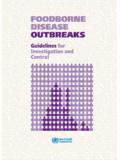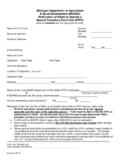Transcription of CDC Estimates of Foodborne Illness in the United …
1 National Center for Emerging & Zoonotic Infectious DiseasesDivision of Foodborne , Waterborne, and Environmental DiseasesCS218786-A CDC 2011 EstimatesFINDINGSCDC Estimates of Foodborne Illness in the United StatesCDC Estimates that each year roughly 1 in 6 Americans (or 48 million people) gets sick, 128,000 are hospitalized, and 3,000 die of Foodborne diseases. The 2011 Estimates provide the most accurate picture yet of which Foodborne bacteria, viruses, microbes ( pathogens ) are causing the most illnesses in the United States, as well as estimating the number of Foodborne illnesses without a known cause.* The Estimates show that there is still much work to be done specifically in focusing efforts on the top known pathogens and identifying the causes of Foodborne Illness and death without a known cause.
2 Foodborne agentsEstimated annual number of illnesses (90% credible interval)%Estimated annual number of hospitalizations (90% credible interval)%Estimated annual number of deaths (90% credible interval)%31 known million ( million)2055,961 (39,534 75,741)441,351 (712 2,268)44 Unspecified million ( million)8071,878 (9,924 157,340)561,686 (369 3,338) million ( million)100127,839 (62,529 215,562)1003,037 (1,492 4,983)100 Table 1. Estimated annual number of domestically acquired Foodborne illnesses, hospitalizations, and deaths due to 31 pathogens and unspecified agents transmitted through food, United StatesCDC has Estimates for two major groups of Foodborne illnesses:Known Foodborne pathogens 31 pathogens known to cause Foodborne Illness . Many of these pathogens are tracked by public health systems that track diseases and outbreaks.
3 *Unspecified agents Agents with insufficient data to estimate agent-specific burden; known agents not yet identified as causing Foodborne Illness ; microbes, chemicals, or other substances known to be in food whose ability to cause Illness is unproven; and agents not yet identified. Because you can t track what isn t yet identified, Estimates for this group of agents started with the health effects or symptoms that they are most likely to cause acute estimate the total number of Foodborne illnesses, CDC estimated the number of illnesses caused by both known and unspecified agents. We also estimated the number of hospitalizations and deaths caused by these illnesses. Table 1 provides the Estimates due to known pathogens, unspecified agents, and the total burden. Reducing Foodborne Illness by 10% would keep about 5 million Americans from getting sick each year.
4 February 2011 causing the most illnesses, hospitalizations, and deaths each yearEight known pathogens account for the vast majority of illnesses, hospitalizations, and deaths. Tables 2 4 list the top five pathogens causing Illness , hospitalization, and annual number of illnesses90% Credible Interval%Norovirus5,461,731 3,227,078 8,309,48058 Salmonella, nontyphoidal1,027,561 644,786 1,679,66711 Clostridium perfringens965,958192,316 2,483,30910 Campylobacter ,024 337,031 1,611,0839 Staphylococcus aureus241,148 72,341 529,4173 Subtotal91 PathogenEstimated annual number of hospitalizations90% Credible Interval%Salmonella, nontyphoidal19,336 8,545 37,49035 Norovirus14,663 8,097 23,32326 Campylobacter ,463 4,300 15,22715 Toxoplasma gondii4,428 3,060 7,1468E. coli (STEC) O1572,138549 4,6144 Subtotal88 PathogenEstimated annual number of deaths90% Credible Interval%Salmonella, nontyphoidal378 0 1,01128 Toxoplasma gondii327 200 48224 Listeria monocytogenes255 0 73319 Norovirus149 84 23711 Campylobacter 0 3326 Subtotal88 Table 2.
5 Top five pathogens causing domestically acquired Foodborne illnesses Table 3. Top five pathogens causing domestically acquired Foodborne illnesses resulting in hospitalization Table 4. Top five pathogens causing domestically acquired Foodborne illnesses resulting in death












